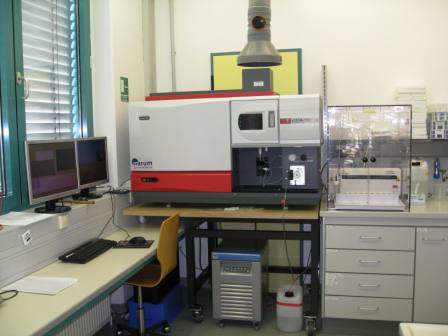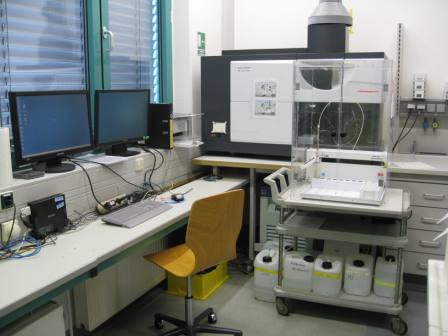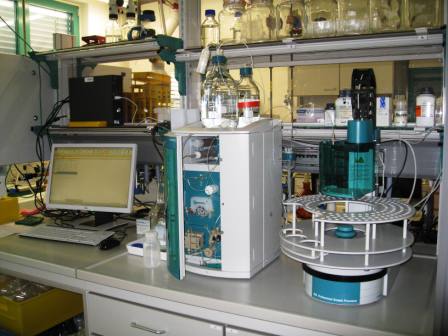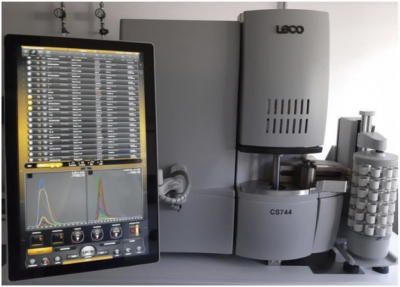Geochemistry
It is important to follow standard laboratory procedures throughout all analytical operations during both offshore and onshore phases of MSP expeditions.
Keeping the working areas clean is a prerequisite for avoiding contamination of cores and samples.
Routine sample handling procedures and all deviations must be documented to ensure the reproducibility and QA/QC of the resulting data.
Example IODP Exp. 302 (ACEX)
Example IODP Exp. 310 (Tahiti)
Example IODP Exp. 313 (New Jersey)
Example IODP Exp. 325 (Great Barrier Reef)
Example IODP Exp. 347 (Baltic Sea Paleoenvironment)
Example IODP Exp. 357 (Atlantis Massif Serpentinization and Life)
Example IODP Exp. 364 (Chicxulub: Drilling the K-Pg Impact Crater)
Example IODP Exp. 381 (Corinth Active Rift Development)
Offshore - Acquisition of Interstitial Water samples (IW)
Interstitial waters (IW) are acquired either from high pressure squeezing of whole round core samples, or directly from the cores using the far less destructive Rhizone sampling technique.
The IW samples are dispensed into aliquots in priority according to:
• the IODP standard measurements,
• the scientific objectives of the expedition,
• the agreed expedition split plan,
• and the available IW volume.
Onboard MSP platforms, IW aliquots are analyzed for salinity, pH / alkalinity and ammonium (ephemeral properties).
Onshore - Extended Analyses of IW and Overview Analysis of sediment / rock samples
During the Onshore Science Party (OSP) additional IW analyses and overview analysis on sediment / rock samples will be undertaken.
Major and Minor Element Analysis - ICP-OES
Major elements of the interstitial water samples are analyzed using a Varian Vista Pro CCD simultaneous inductively coupled plasma–optical emission spectrometer (ICP-OES) with a radial plasma.
Trace elements of the interstitial water samples are analyzed using an Agilent Technologies 700 Series ICP-OES with an axial plasma.
The measurements are conducted with an acidified aliquot (cation split) spiked with 10 µL conc. HNO3/mL sample.
Elements:
Major elements: Al, B, Ba, Ca, Fe, K, Mg, Mn, Na, P, S, Si, Sr, Ti
Trace elements: Al, As, Ba, Be, Cd, Ca, Cr, Cu, Fe, Li, Mn, Mo, Ni, P, Pb, Rb, Sr, Ti, V, Zn, Zr
Assembly:
Major elements: ICP-OES with a sea-spray nebulizer and a cyclon spray chamber
Trace elements: ICP-OES with a K-style conical nebulizer
The required dilution sets are adapted to adequate diluted seawater Na-contents.
Calibration:
Standardization is performed against multi-element solutions prepared from commercial single element standard solutions (National Institute of Standards and Technology Certified Reference Material® NIST CRM) with either a 1% HNO3 matrix, or a 1% HNO3 matrix adjusted to a similar NaCl concentration of the diluted samples.
Reference Material:
IAPSO Standard Seawater from Osil® is used as an external reference material.
Measurement precision:
Major elements: 1-σ: < ± 2%
Trace elements: 1-σ: < ± 5%
Anion Analysis (IW) – IC
Anions are analyzed by ion chromatography (IC) using a Metrohm 882 Compact Ion Chromatograph with an 858 Professional Sample Processor.
The measurements are conducted with a filtered and un-acidified IW aliquot (anion split).
Anions:
Chloride, Bromide, Sulfate
Assembly:
Metrohm 882 Compact Ion Chromatograph with an 858 Professional Sample Processor with Sequential Compression. Separation over a Metrosep A Supp 5 column (150 x 4.0 mm, 5 um particle size) and two guard columns (Metrosep A Supp 4/5 4.0 mm and Metrosep RP2 Guard 3.6).
Calibration:
Standardization is performed against multi-element solutions prepared from commercial single element standard solutions (National Institute of Standards and Technology Certified Reference Material® NIST CRM).
Reference material:
IAPSO Standard Seawater from Osil® is used as an external reference material.
Measurement precision:
Chloride: 1-σ: < ± 1.0%
Bromide: 1-σ: < ± 5.0%
Sulfate: 1-σ: < ± 2.0%



Onshore - TC/TOC, ED-XRF and C/N Analyses of Sediment, Rock Samples / Carbonate (CaCO3)
TC/TOC/S Analysis (Solid Sample_bulk)
The CS744 LECO instrument measures total carbon, organic carbon and sulphur contents. The analysis is performed by heating 0.1 g of homogenised material in a ceramic dish and measuring the resulting CO2 and SO2 in IR cells, which provide carbon and sulphur contents.
Carbonate content (Ccarb) is determined following two steps. First, total carbon content is analysed in one sample. Then, carbon content is measured in a sample that was pretreated with hydrochloric acid to remove carbonates. Ccarb-content is then calculated from these two measurements.
The instrument works according to standard test methods, such as ISO 9556, ISO 10719, ASTM E1941, ASTM E1019, ASTM E1941 and the international equivalences.
The measurements are conducted on aliquots (100 mg) of a ground and homogenized solid sample.
Species:
TC - Total carbon, TOC - total organic carbon, TS - total sulfur.
Carbonate content is calculated from these result.
Assembly:
LECO CS 744 carbon-sulfur analyzer with Shuttleloader
Measuring principle:
Approximately 100 mg of the homogenized sample is weighed in exactly in a sterile ceramic boat and combusted at 2200°C in a stream of purified Oxygen (Carrier gas). The evolved CO2 and SO2 are measured with a non-dispersive infrared detector to quantify TC and TS sample content. To determine TOC, another 100 mg sample aliquot is first decalcified using 12.5% HCl to remove inorganic carbonate, dried and then combusted / analyzed as described above. Total inorganic carbon (TIC) is determined by subtracting TOC from TC. Data is reported in weight percent (wt%) dry sample.
Reference material:
Commercial certified reference material and certified one-use reference pieces.
Measurement precision:
TC/TOC - C: 1-σ ± 1,0% C
Sulfur - S: 1-σ ± 1,5% C
ED-XRF Analysis (Solid Sample_bulk)
The measurements are conducted on aliquots (4000 mg) of ground and homogenized solid samples.
Species:
Bulk elemental composition
Assembly:
XRF PANalytical Epsilon 3XLE
Measuring principle:
Exactly 4000 mg of the homogenized sample is weighed in a sample vial and compacted with 25 kg of pressure. Ten prepared samples per analytical run are analysed for bulk elemental composition using the benchtop energy dispersive X-ray fluorescence (EDXRF) spectrometer Epsilon 3XLE (PANalytical).
Reference material:
General - Mastercalibration from over 40 commercial certified reference calibration materials.
Special - Dependent on the exact core material (e.g. marine and freshwater sediments, rocks, soils) additional certified reference material are applied as needed.
Measurement precision:
Based on element, utilized calibration standard and dependent on core material: 1-σ ± 0.1 - 3.0%
C and N Analysis with CHNS Analyzer (Solid Sample_bulk)
C and N are analyzed with a Vario EL3 CHNS analyzer by Elementar.
The measurements are conducted on aliquots (20-30 mg/1g) of a ground and homogenized solid sample.
Species:
TC - Total carbon, TOC - total organic carbon, N - total nitrogen.
Assembly:
Vario EL3 CHNS analyzer by Elementar®
Measuring principle:
To determine TC/N, ~ 20-30 mg of the homogenized sample is weighed in precisely in a Zinn capsule and combusted at 950°C in a stream of purified Oxygen (Carrier gas). The evolved CO2 and NO2 are measured via TCD/IR detection.
To determine TOC, ideally ~1 g (min. 500 mg) of the homogenized sample is weighed in precisely into a separate glass vial as a second sample aliquot, decalcified using 10% HCl to remove inorganic carbonate, washed and centrifuged. Then a ~ 20-30 mg split of that treated sample aliquot is weighed in precisely in a Zinn capsule and then combusted and analyzed as described above.
Data is reported in weight percent (wt%) dry sample.
Reference material:
Commercial certified reference material.
Determination limit:
TC/TOC - C: 1-σ ± 1,0% C
Nitrogen - N: 1-σ ± 0,1% C



